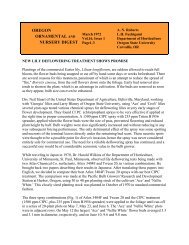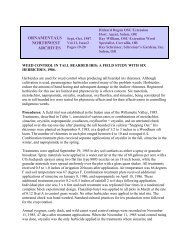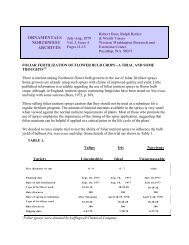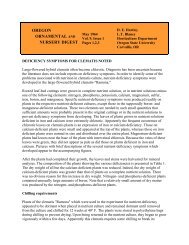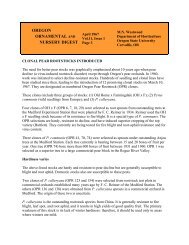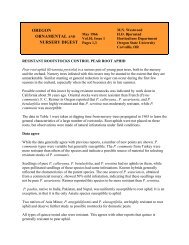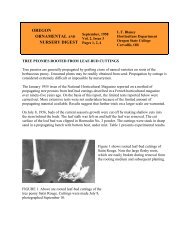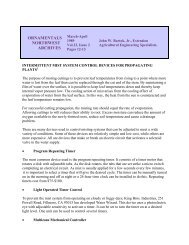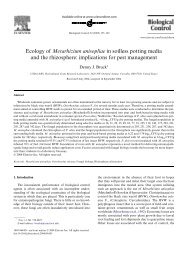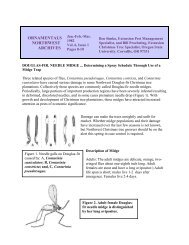Spraying Leaves of Pear Nursery Trees with Urea and Copper ...
Spraying Leaves of Pear Nursery Trees with Urea and Copper ...
Spraying Leaves of Pear Nursery Trees with Urea and Copper ...
Create successful ePaper yourself
Turn your PDF publications into a flip-book with our unique Google optimized e-Paper software.
RESEARCH REPORTS<br />
Fig. 3. Nitrogen concentration in stems (A) <strong>and</strong> the size <strong>of</strong> lesions (B) caused by<br />
Phytophthora syringae infection on stems <strong>of</strong> ‘OHF 97’ pear rootstock sprayed <strong>with</strong><br />
urea, chelated copper ethylenediaminetetraacetic acid (CuEDTA), <strong>and</strong> a fungicide<br />
solution composed <strong>of</strong> phosphorus acid neutralized <strong>with</strong> potassium hydroxide<br />
[PFOS (PhytoFOS; Sipcam Agro USA, Research Triangle Park, NC)] in October or<br />
November. <strong>Trees</strong> sprayed <strong>with</strong> water (Water), a solution <strong>of</strong> urea <strong>and</strong> CuEDTA<br />
(<strong>Urea</strong>), a solution <strong>of</strong> PFOS (PFOS), or a solution <strong>of</strong> urea <strong>and</strong> PFOS (<strong>Urea</strong> + PFOS)<br />
on 22 Oct. (Oct.) or 24 Nov. 2004 (Nov.) <strong>and</strong> inoculated <strong>with</strong> pathogen 7 d before<br />
spraying (27 d), or 2, 7, or 21 d (+2d, +7d, or +21d) after spraying. Stems were<br />
collected for analyses 8 weeks after inoculation. Columns represent means <strong>and</strong> error<br />
bars are se (n = 16). Columns denoted <strong>with</strong> the same lower case letters are not<br />
significantly different (lesion size: Kruskal-Wallis test at P < 0.05; stem N: Tukey’s<br />
honestly significant difference test at P < 0.05); 1 cm = 0.3937 inch, 1 mgg 21 =<br />
1000 ppm.<br />
wounding may be essential for P.<br />
syringae infection <strong>of</strong> pear stems under<br />
the environmental conditions in<br />
our test system. Others have reported<br />
that P. syringae was unsuccessful in<br />
causing infection to uninjured bark<br />
<strong>of</strong> almond [Prunus dulcis (Bostock<br />
<strong>and</strong> Doster, 1985; De Bruyn, 1924;<br />
Linderman, 1986)], <strong>and</strong> P. syringae can<br />
infect wounds caused by h<strong>and</strong>ling or<br />
pruning or through leaves <strong>and</strong> leaf scars<br />
(De Bruyn, 1924; Linderman, 1986).<br />
In artificial inoculations <strong>of</strong> P. syringae in<br />
rhododendron (Rhododendron spp.),<br />
wounds <strong>and</strong> low temperatures were<br />
a prerequisite for infection (Linderman,<br />
1986).<br />
The activity <strong>of</strong> P. syringae is restricted<br />
to cold climates, <strong>and</strong> increased<br />
activity <strong>of</strong> the pathogen<br />
coincides <strong>with</strong> the dormancy period<br />
<strong>of</strong> deciduous trees (Duniway, 1983;<br />
Erwin <strong>and</strong> Ribeiro, 1996). Apple<br />
[Malus ·domestica (Sewell <strong>and</strong><br />
Wilson, 1973)] <strong>and</strong> lilac [Syringa vulgaris<br />
(De Bruyn, 1924)] were more<br />
susceptible to P. syringae infection<br />
during the dormant period than in<br />
the actively growing period. The pathogen<br />
activity in apple (Sewell <strong>and</strong><br />
Wilson, 1973) <strong>and</strong> almond (Bostock<br />
<strong>and</strong> Doster, 1985) was higher in<br />
cooler months at lower temperatures.<br />
This was also reported for the activity<br />
<strong>of</strong> this pathogen in orchard soil in<br />
southeastern Engl<strong>and</strong> where the pathogen<br />
was quiescent during warmer<br />
months <strong>and</strong> active in cooler months<br />
(Harris, 1979). In bareroot nurseries,<br />
lifting <strong>of</strong> trees in the PNW coincides<br />
<strong>with</strong> the greatest activity <strong>of</strong> P. syringae.<br />
If infection occurs during this time<br />
<strong>and</strong> conditions that are conducive<br />
for pathogen activity follow, the risk<br />
<strong>of</strong> infection could be high, especially<br />
during cold storage, because the fungus<br />
can actively grow at low temperatures<br />
(Pscheidt <strong>and</strong> Ocamb, 2002).<br />
UREA SPRAYS AND SUSCEPTIBILITY.<br />
In Expt. 2, spraying trees <strong>with</strong> urea<br />
in October increased N concentration<br />
<strong>and</strong> decreased tree susceptibility to<br />
P. syringae, while spraying trees<br />
<strong>with</strong> urea in November increased N<br />
concentrations <strong>and</strong> lesion size. This<br />
contrasting relationship between N<br />
concentration <strong>and</strong> the size <strong>of</strong> lesions<br />
between October <strong>and</strong> November suggests<br />
that time <strong>of</strong> year plays an important<br />
role in tree susceptible to P.<br />
syringae beyond the effects <strong>of</strong> urea on<br />
N status.<br />
The results from Expt. 3 support<br />
our hypothesis that the relationship<br />
between stem N concentration <strong>and</strong><br />
susceptibility varies during the autumn.<br />
Concentrations <strong>of</strong> N in stems<br />
from trees sprayed <strong>with</strong> urea in November<br />
were greater than in stems<br />
from trees sprayed in October, <strong>and</strong><br />
lesions on stems from trees sprayed<br />
<strong>with</strong> urea were larger in November<br />
than in October. Compared <strong>with</strong><br />
trees sprayed <strong>with</strong> water, spraying<br />
trees <strong>with</strong> urea in October had no<br />
influence on lesion size <strong>and</strong> increased<br />
stem N concentration, <strong>and</strong> spraying<br />
trees <strong>with</strong> urea in November decreased<br />
lesions size <strong>and</strong> increased<br />
stem N concentration. These results<br />
are important because they indicate<br />
that the timing <strong>of</strong> urea sprays can<br />
differentially influence tree N concentrations<br />
<strong>with</strong>out altering susceptibility<br />
to P. syringae. Similarly, spraying<br />
pear trees <strong>with</strong> a combination <strong>of</strong> urea<br />
<strong>and</strong> CuEDTA had no influence on<br />
lesion size regardless <strong>of</strong> the growing<br />
environment before or after inoculation<br />
(Laywisadkul, 2008). These results<br />
suggest that the combined<br />
effects <strong>of</strong> urea <strong>and</strong> CuEDTA on stem<br />
N concentrations do not increase susceptibility<br />
<strong>of</strong> pear trees to P. syringae.<br />
In general, our results indicate<br />
that spraying trees <strong>with</strong> urea has no<br />
effect on disease incidence <strong>and</strong> is<br />
338 • April 2010 20(2)





